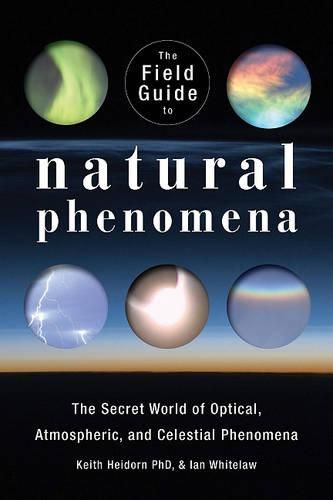Readings Newsletter
Become a Readings Member to make your shopping experience even easier.
Sign in or sign up for free!
You’re not far away from qualifying for FREE standard shipping within Australia
You’ve qualified for FREE standard shipping within Australia
The cart is loading…






A vivid portrait of nature’s most fascinating and unexpected events.
This is an illustrated guide to nature’s most theatrical and mysterious events, from eclipses and the aurora borealis to rainbows and light pillars. Dr. Keith Heidorn combines engaging text with color photographs and line drawings to describe each phenomenon in simple, non-technical terms.
The field guide examines the origins and behaviors of natural phenomena and draws on science, history, folklore, travel and other disciplines. Some are familiar events, yet others are once-in-a-lifetime spectacles. They include:
Optical phenomena, such as green flashes, crepuscular rays, coronas, mirages
Atmospheric phenomena, such as dust devils, haboobs, lenticular clouds, pea soupers
Electrical phenomena, such as ball lightning, St. Elmo’s fire, will-o’-the-wisps
Aquatic phenomena, such as ice circles, diamond dust, tidal bores, waterspouts
Geological phenomena, such as stone arches, mud pots, petrified forests, salt lakes
Celestial phenomena, such as meteors, comets, eclipses, the Milky Way
Sixteen identification guides detail the phenomena and how each occurs.
The Field Guide to Natural Phenomena provides specific information for general readers and weather watchers about where and when nature puts on these creative performances.
$9.00 standard shipping within Australia
FREE standard shipping within Australia for orders over $100.00
Express & International shipping calculated at checkout
A vivid portrait of nature’s most fascinating and unexpected events.
This is an illustrated guide to nature’s most theatrical and mysterious events, from eclipses and the aurora borealis to rainbows and light pillars. Dr. Keith Heidorn combines engaging text with color photographs and line drawings to describe each phenomenon in simple, non-technical terms.
The field guide examines the origins and behaviors of natural phenomena and draws on science, history, folklore, travel and other disciplines. Some are familiar events, yet others are once-in-a-lifetime spectacles. They include:
Optical phenomena, such as green flashes, crepuscular rays, coronas, mirages
Atmospheric phenomena, such as dust devils, haboobs, lenticular clouds, pea soupers
Electrical phenomena, such as ball lightning, St. Elmo’s fire, will-o’-the-wisps
Aquatic phenomena, such as ice circles, diamond dust, tidal bores, waterspouts
Geological phenomena, such as stone arches, mud pots, petrified forests, salt lakes
Celestial phenomena, such as meteors, comets, eclipses, the Milky Way
Sixteen identification guides detail the phenomena and how each occurs.
The Field Guide to Natural Phenomena provides specific information for general readers and weather watchers about where and when nature puts on these creative performances.